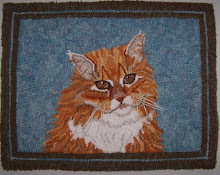
With every rug I hook, I learn a little more. I have always liked the look of the primitive antique rugs that I see in books and magazines. They have an innocent charming appeal, some are whimsical and fun, others have intricate designs with wonderful colors, there are those that tell a story, and some are very utilitarian and plain. I love the whimsical and fun and so I chose to make our cat Max with a folk art look.
From what I have gathered from my hooking books, rugs were hooked for necessity and the fact that commercial rugs were not affordable to everyone. Hooked rugs were used, worn out, thrown out, and another was made to take it's place. Because of this, not very many hooked rugs survived. It is so wonderful to see the ones that did survive, and it makes me curious about the creative person who hooked them.
We can tell a lot from the antique rugs that have survived. What backings were used, if they used wool or cotton fabrics (or other things for that matter), the colors that were used, and how the rugs were bound. It is a look back into an era of what was available to the hooker at that time.
Most think that hookers of the past used dull and washed out colors of fabric, however the back side of antique rugs reveal that much brighter colors were hooked into the rugs. The color had faded from sunlight and wear, so a truer picture of the rug is seen from the back.
I liked the worn and faded look of the antique rug and I tried to make my project resemble that look. My first attempt at the Hit and Miss boarder was a little too bright, so I pulled out strips and re-hooked other colors. Here is a side by side before and after picture of the left side.

I continued around the rug with lambs tongues, squares and fans. The background is various white and cream wools, then I added an old date that I pick out of the blue.

The rug and Max . . . .

And now the true test, does the rug wear well . . .




I'm guessing this is what the rug would look like prodded.



































